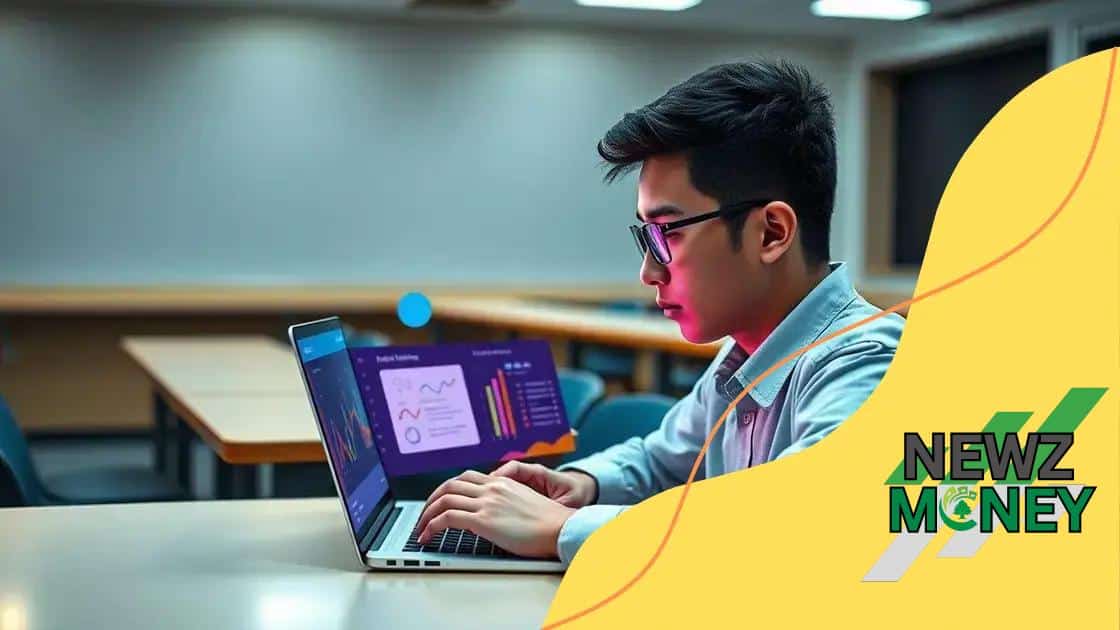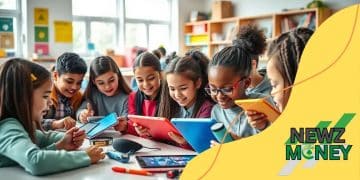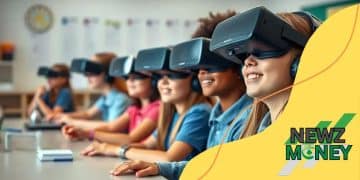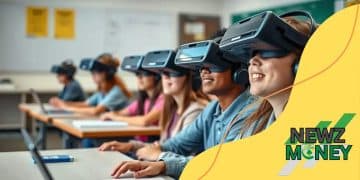Innovations in remote learning technology for students

Innovations in remote learning technology, including AI, virtual reality, and adaptive learning tools, are personalizing education and enhancing student engagement for a more effective learning experience.
Innovations in remote learning technology for students are changing the educational landscape. Have you ever wondered how these advancements impact the way we learn from home? In this article, we will dive into how technology is revolutionizing education.
Emerging technologies reshaping online classrooms
Emerging technologies reshaping online classrooms are making a considerable impact on education today. They provide innovative solutions for both students and teachers, enhancing the learning experience. By using these technologies, students can connect and engage more effectively, regardless of their location.
Virtual classrooms and enhanced interaction
Virtual classrooms are becoming the norm in education. With tools like Zoom and Microsoft Teams, students participate actively in discussions. This engagement is crucial as it fosters a sense of belonging. In a virtual environment, students can:
- Ask questions in real-time
- Collaborate on projects through breakout rooms
- Share their ideas easily during group discussions
Such interactions help bridge the gap created by physical distances. Technology encourages a more participative approach to learning, empowering students to take charge of their education.
Adaptive learning technologies
Another exciting development is adaptive learning technologies. These systems adjust the learning material based on individual performance. With tools powered by artificial intelligence, students receive tailored content, making learning more effective.
For instance, if a student struggles with a topic, the technology can redirect them to resources that reinforce understanding. This personalized approach not only aids learning but also boosts confidence. Additionally, students can progress at their own pace, receiving support when needed.
As these emerging technologies reshape online classrooms, students benefit from a blend of innovative tools and personalized learning experiences. This synergy is key to fostering an engaging educational environment.
The role of virtual reality in remote learning
The role of virtual reality in remote learning is becoming increasingly important as technology advances. This immersive technology allows students to experience learning in a whole new way. Instead of just reading about historical events or scientific concepts, they can now step into these worlds firsthand.
Immersive experiences enhance understanding
Virtual reality (VR) can transform a traditional lesson into an engaging exploration. Imagine students walking through ancient civilizations or visiting the ocean floor without leaving their homes. These experiences help deepen their understanding of the subject matter.
- Visit historical sites in virtual field trips
- Engage in interactive science experiments
- Participate in simulated real-world scenarios
This hands-on approach not only makes learning more enjoyable but also helps students retain information better. As they become active participants, their interest in the subject grows.
Collaboration and social learning
Another benefit of incorporating VR in remote learning is the ability to collaborate with peers. Students can join virtual classrooms where they interact with classmates worldwide. This connectivity promotes teamwork and communication skills, crucial for their future careers.
Through VR, students can engage in group projects, share ideas, and solve problems together, all while feeling like they’re in the same room. This sense of camaraderie helps to build a community even in a remote learning setting.
As the role of virtual reality in remote learning expands, educators have the opportunity to redefine teaching methods. This shift can lead to heightened engagement, collaborative learning, and an enriched educational experience for students.
How AI is personalizing education experiences

How AI is personalizing education experiences is a key topic in modern learning. Artificial intelligence (AI) tailors education to fit individual student needs, making learning both effective and engaging. With AI, students can receive personalized feedback and resources based on their unique strengths and weaknesses.
Adaptive learning platforms
Adaptive learning platforms use AI algorithms to analyze a student’s performance. These platforms can identify areas where a student excels or struggles. By offering customized resources, they create a more effective learning path.
- Provide targeted exercises for improvement
- Adjust learning pace according to proficiency
- Recommend additional materials for mastery
As students progress, the AI system continuously updates their learning plan, ensuring they receive the support they need. This individualized approach helps maintain engagement and motivation.
AI-driven assessment tools
Another way AI personalizes education is through assessment tools that provide instant feedback. These tools analyze answers and offer insights into student understanding. Students can learn from their mistakes immediately, reinforcing concepts while they are still fresh.
Moreover, teachers can access valuable data about class performance. This information helps them tailor their instruction to better meet the needs of their students. When teachers understand how each student learns, they can provide targeted support and adjustments.
The impact of AI in personalizing education experiences is profound. As technology continues to evolve, the possibilities for creating tailored learning environments will expand, leading to better educational outcomes.
Best practices for effective remote learning
Best practices for effective remote learning are essential for ensuring that students receive quality education from home. Implementing the right strategies enhances engagement and academic performance. By following these practices, educators can create a more dynamic learning environment.
Establish a structured routine
Having a clear schedule is crucial for remote learning. When students know what to expect, they are more likely to stay focused and organized. A typical day might include:
- Set times for attending virtual classes
- Scheduled breaks to prevent burnout
- Dedicating time for independent study
Encouraging students to stick to this routine helps them manage their time effectively and reduces distractions.
Utilize interactive tools and resources
Virtual learning tools play a significant role in maintaining student interest. Using platforms that promote interaction keeps students engaged. Tools such as:
- Online quizzes and polls
- Discussion boards for peer collaboration
- Interactive presentation software
These resources can enhance the learning experience by making lessons more enjoyable and engaging.
Regular communication also helps maintain relationships between students and teachers. Through video calls, emails, and chat, students should feel supported and connected. Providing feedback promptly encourages students and helps them understand their progress.
Incorporating best practices in remote learning ensures educators meet the diverse needs of their students. As technology continues to evolve, these strategies will help create a rich and effective educational experience.
Future trends in remote education technology
Future trends in remote education technology are shaping how students learn and engage with educational content. As technology evolves, schools and educators are adapting to new tools that enhance learning experiences. This evolution is not just about technology; it’s about making education more accessible and effective for all.
Increased use of Artificial Intelligence
One major trend is the increased use of artificial intelligence in education. AI can help in various ways, such as providing personalized learning paths for students. By analyzing student performance, AI can suggest resources that cater to individual needs.
- AI chatbots for instant student support
- Intelligent tutoring systems for customized feedback
- Data analytics to track student progress
This will allow educators to focus more on teaching while AI manages administrative tasks.
Virtual and augmented reality integration
Another exciting trend is the integration of virtual and augmented reality (VR and AR) into remote learning. These technologies offer immersive learning experiences that make education more engaging. Imagine students using VR to explore historical sites or conduct science experiments in a virtual lab. Such experiences can deepen understanding and retain interest in the subject matter.
This integration not only elevates the education experience but also prepares students for a tech-driven world. As schools invest in VR and AR tools, the possibilities for interactive learning become limitless.
Lastly, the growth of online collaboration tools cannot be overlooked. Platforms that facilitate group work will continue to evolve. As remote learning becomes more prevalent, tools that enhance communication and teamwork will play a critical role in education.
The future trends in remote education technology highlight a continued shift towards more interactive, personalized, and accessible learning environments, paving the way for a new era in education.
FAQ – Frequently Asked Questions about Remote Learning Technology
What role does AI play in remote learning?
AI personalizes learning experiences by analyzing student performance and providing tailored resources to meet individual needs.
How can virtual reality enhance education?
Virtual reality offers immersive experiences that engage students by allowing them to explore subjects in a hands-on manner, improving retention and understanding.
What are some effective tools for online collaboration?
Tools like Google Classroom, Microsoft Teams, and Zoom facilitate communication and collaboration among students and teachers in a remote setting.
Why is establishing a routine important for remote learners?
A structured routine helps students stay organized, minimizes distractions, and fosters a productive learning environment at home.





